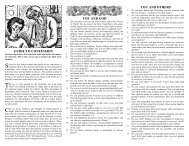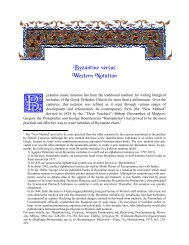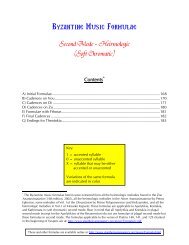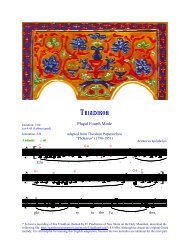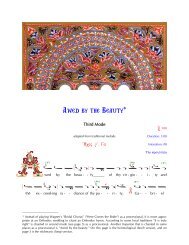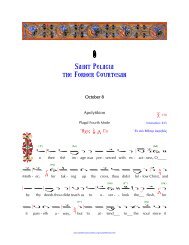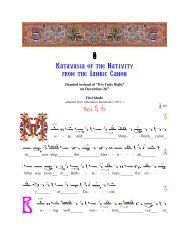Reading Psalmodia (PDF) - St. Anthony's Monastery
Reading Psalmodia (PDF) - St. Anthony's Monastery
Reading Psalmodia (PDF) - St. Anthony's Monastery
You also want an ePaper? Increase the reach of your titles
YUMPU automatically turns print PDFs into web optimized ePapers that Google loves.
THE VOICE.The Psaltes needs to have an accurate sense of pitch and a voice appropriate to theliturgical ministry he or she is to exercise. A weak or unsteady voice is undesirable.The modern habit of introducing microphones into the church has at least the meritof enabling singers with particularly quiet voices to function more effectively asPsaltai.Ideally, a Psaltes should have a clear, accurately pitched, melodious and pleasingvoice and a range encompassing at least the two octaves from low to high F or low tohigh G.Singers trained in operatic or lieder styles need to learn a quite different approach tosinging before they can sing Psaltic music. Psaltic chanting is essentially a religiousact, not a musical performance and certainly not a dramatic performance. Thecongregation is not an audience to be entertained and impressed. The liturgicaloffices are prayer offered in the presence of the Living God, not an exotic form oforatorio. They are part of the public prayer of the Church, not an exercise in personaldevotion. The Psaltes exercises a ministry on behalf of the congregation; that issomething quite different from giving a musical performance for the people’sedification.THE FORMS of CHANT.The Liturgical offices contain a wide variety of chant. The Psaltes needs tounderstand and appreciate the character and function of each.A] LITANIESThe Byzantine Rite is particularly rich in litanies, from the catena of petitions of theEirenika to the brief dialogue of the Small Ektenia. Essentially a Litany is a dialogue,usually between deacon and people; the deacon (or the priest) chants a petition towhich the people, led by the Psaltai, make a brief, simple response, e.g. "Lord havemercy," or "Grant this, O Lord." Each Litany normally ends with a brief prayer ofcommendation, to which the people reply "To You, O Lord," and a doxology sung bythe priest, to which the response is "Amen."The Litany is, and is meant to be, a simple, popular form of prayer. The responsesbelong to the people, and are one form of chant it is easy to return to the people,especially if the Psaltai are content to give an effective lead, and keep, generally, tosimple traditional melodies.If the Psaltai do make the responses to the litanies, the usual custom is for one choirto make the first six responses of a set of twelve, the other the next six. It is equallypossible for the two sides to respond alternately, or for sets of responses to be brokeninto clusters of three or four.B] LITURGICAL DIALOGUEBesides the Litanies, there are many other forms of liturgical dialogue in theByzantine Rite. The Leitourgika are the most important instance. The Leitourgika arenormally sung in the Tone (Echos) of the day. This is the norm, but in practice manychurches do not follow it, and use a narrow range of chants traditional in that





